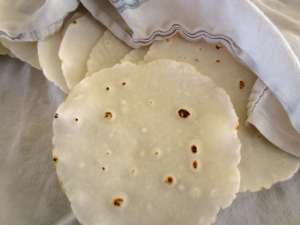 Hubby loves Mexican food. When we were planning our wedding he wanted to have a burrito bar for food. I was worried about getting sauce on my dress, so we opted to do a burrito bar for the rehearsal dinner. My super awesome friend made the burrito bar amazing, and my sister-in-law might have as well. Things are kind of fuzzy that far back. I do remember that they both made the wedding food amazing, but I can’t remember the rehearsal dinner.
Hubby loves Mexican food. When we were planning our wedding he wanted to have a burrito bar for food. I was worried about getting sauce on my dress, so we opted to do a burrito bar for the rehearsal dinner. My super awesome friend made the burrito bar amazing, and my sister-in-law might have as well. Things are kind of fuzzy that far back. I do remember that they both made the wedding food amazing, but I can’t remember the rehearsal dinner.
Anyway, I make tortillas. A lot. I do corn mostly, because they’re easier and they’re naturally gluten free, but I had wondered for a while if I could make flour tortillas. As with anything gluten free, it has its challenges. Here are some tips for gluten free flour tortilla making:
Use a cast iron skillet (or comal). I was using a T-fal griddle pan for a while, but the cast iron does much, much better.
Do grease the skillet. If you have a seasoned skillet it’s not as important, but it helps a lot. I recommend lard for this. Only use enough to get a thin layer and re-coat every 2 or 3 tortillas. If you’re vegan, palm shortening would be a good substitute.
Use lard. I have used palm shortening before and, while it works, it just isn’t as good. If you’re vegan, palm shortening is a great option. If not, invest in some lard, you won’t regret it.
Warm water. Most flour tortilla recipes call for cold water. While cold water works, it adds more prep time because you have to cut the fat in really well before you add the water. Using warm water melts the fat a little, helping it distribute evenly through the dough which makes the cooked tortilla better.
Medium heat, short cook time. If you want flexible tortillas don’t cook them for longer than 1 minute and 30 seconds. If you overcook them, they’ll break when bent.
Do not skip the xanthan gum. Seriously. Do. Not. I was out once and I thought I’d just sub in some almond flour for the rice flour because almond flour is good for texture in gluten free stuff like pizza crust. Wrong. My tortillas just broke apart. The xanthan gum is for texture and structure, it is not optional.
Use a tortilla press. Press your dough first and then roll it out with a rolling pin. This way you get a more even looking tortilla.
Cover the cooked tortillas. They will dry out quickly otherwise.
Flour Tortillas (GF)
1/2 cup brown rice flour
Generous 1/2 cup tapioca starch
1 teaspoon xanthan gum
1/2 teaspoon baking powder
1/2 teaspoon salt
2 tablespoons lard
3/4 cup warm water
- Combine dry ingredients. Add lard and work into the flour a little. Add in the warm water and stir with a wooden spoon.
- Once the dough begins to come together a little start squeezing it together with your hands. Do this until the dough feels like play-doh and mostly holds together. It’s ok if a chunk falls off every now and then, the important part is that it holds it’s shape when squeezed. This should take about 5 minutes.
- Cover with plastic wrap and let it rest for 20 minutes.
- Preheat the skillet.
- Pinch off about 2 tablespoons of dough, roll into a ball and squish in a tortilla press between two pieces of plastic wrap. Move it to the counter and roll it thin while it’s still in the plastic wrap.
- Grease the skillet.
- Peel the top piece of plastic wrap off and lay it back on the tortilla press for the next tortilla. Flip the rolled dough onto your hand and gently peel the second piece off, draping on the top part of the tortilla press to be used for the next tortilla.
- Cook the tortilla for 1 minute, flip and cook for 30 seconds more. Remove and place on a plate, covering it with a towel.
- Repeat until finished.
- Enjoy.

 Melissa Naasko is a friend of mine, so reading this book was a little like sitting and listening to her talk about food. She moved away a few years ago, so it was nice to read this and “hear” her voice for a bit. She is a wonderful woman and I miss hearing her stories.
Melissa Naasko is a friend of mine, so reading this book was a little like sitting and listening to her talk about food. She moved away a few years ago, so it was nice to read this and “hear” her voice for a bit. She is a wonderful woman and I miss hearing her stories.